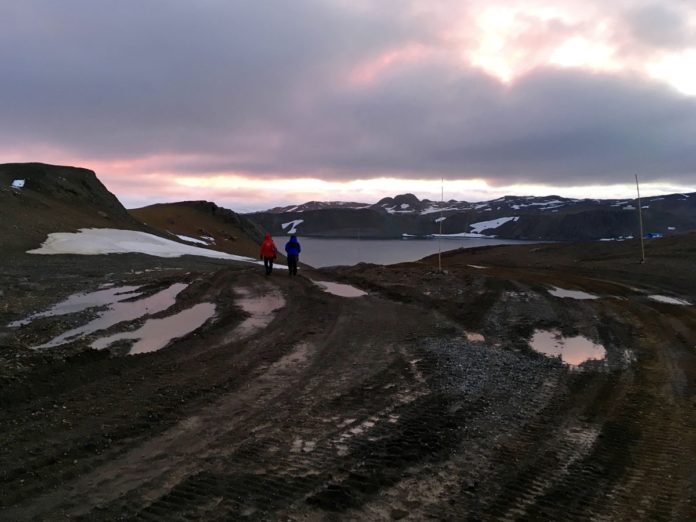Where is the ice? That’s the question that I heard most often when people saw the images from my Antarctica trip. And I have to admit it’s what I asked myself when I first set foot on King George Island, which lies 120 kilometers off the coast off Antarctica and is home to numerous international research stations. For here, the White Continent doesn’t quite live up to its name — King George, the largest of the South Shetland Islands, is only partially covered by ice, part of the reason why countries the world over have chosen to set up their stations there.
 Scientists walk on a beach covered with moss on Fildes peninsula, King George Island, Antarctica on February 1, 2018. (AFP / Mathilde Bellenger)
Scientists walk on a beach covered with moss on Fildes peninsula, King George Island, Antarctica on February 1, 2018. (AFP / Mathilde Bellenger)During the summer in the southern hemisphere, dozens of scientists flock to the Chili’s Julio Escudero research base. That’s how I and several reporters from other media outlets get a chance to visit this corner of the world.
Our trip begins at Punta Arenas, in the south of Patagonia, where we arrive the morning of January 30. The ground rules for our visit are spelled out in an afternoon briefing. Antarctica is not your ordinary continent and if you want to visit, there are strict rules to follow. Nothing — N-O-T-H-I-N-G — can be thrown out into nature; you can’t pick up so much as a tiny plant or rock without prior authorization; you can’t get within three meters of any animals; if an animal gets closer to you, you are under no circumstances allowed to touch it.
 A colony of sea elephants is pictured on Fildes peninsula, King George Island, Antarctica on February 1, 2018. (AFP / Mathilde Bellenger)
A colony of sea elephants is pictured on Fildes peninsula, King George Island, Antarctica on February 1, 2018. (AFP / Mathilde Bellenger)We are supposed to leave for King George the following morning. Supposed to being the key words. This being nearly Antarctica, weather dictates travel. We’re told to keep our phones close and to be ready to leave at any moment, including in the middle of the night. In the end, we leave the following afternoon.
After a two-and-a-hal-hour flight in a 100-seat airplane, an island covered with white spots appears in the distance. We land on a gravel-covered runway, surrounded by hills. In the distance, we see a huge chunk of ice break from the ice shelf. We are in Antarctica.
Before getting out of the plane, we put on the snowsuits, parkas and hats lent to us by the institute before our departure. The temperature outside is quite bearable — between 0 and minus 5 Celsius. We start walking to our base — a few four-by-four vehicles transport luggage, but we walk the 20 minutes to our new temporary home.
King George is home to research bases from around a dozen countries. They look like a village. We are staying at the Chilean base, which includes a gymnasium, a post office, a bank. When I wander toward the Chinese base, my cell phone lights up “Welcome to China.” I take a few steps back, and I’m back in Chile. The Russians, a few meters away, have a church, a small wooden chapel overlooking the bay. There’s even a priest.
 Trinity church, the southernmost Orthodox church in the world, built near a Russian research station, is seen on King George Island, Antarctica on January 31, 2018. (AFP / Mathilde Bellenger)
Trinity church, the southernmost Orthodox church in the world, built near a Russian research station, is seen on King George Island, Antarctica on January 31, 2018. (AFP / Mathilde Bellenger)During the summer, temperatures here hover around zero degrees Celsius, but it can feel much colder because of the wind chill and especially when you’re moving around by boat, the second most popular mode of transport after your own two feet. There is a three-layer rule to clothes here — long underwear, followed by fleece and then pants and parkas.
The base feels like a vacation resort. Scientists usually come here for between one and three months. Their days follow a rhythm of outings to sites and meals. There may be banks and post offices here, but, as the document that I received ahead of the trip clearly told me “There are no stores in Antarctica!” so people must come with their own supplies of whatever it is they want. One of my neighbors in the dormitory took the warning to heart, stuffing her suitcase with treats.
Antarctica is the only continent that has never had an indigenous population and does not have permanent residents. You feel it when you get here — you are lucky enough to be stepping on nearly virgin land. Man is an intruder here, something that the animals never cease to remind him. The skuas (brown seabirds) that make their home here do not hesitate to let imprudent visitors know their place; the elephant seals and sea lions dotting the rocks will readily roar if you approach a bit too close. The only ones who don’t seem to mind the human visitors are the penguins, who seem to be on the beach at all hours and who graciously let us film their regal selves.
 A young Gentoo penguin chirps amidst a colony of penguins on Ardley Island, Antarctic, on February 3, 2018. (AFP / Mathilde Bellenger)
A young Gentoo penguin chirps amidst a colony of penguins on Ardley Island, Antarctic, on February 3, 2018. (AFP / Mathilde Bellenger)One day, we accompany a researcher to a little island of Adley, where there is a colony of Gentoo Penguins. Remembering the instructions we received, I set up my tripod at a respectable distance and start to film. But the penguins are curious, especially the young ones. One is particularly fascinated by my camera and its blue microphone, which he dabs at. I try to step back, but my new assistant has no intention of letting me go. Finally his Mom comes to my rescue, telling him in no uncertain terms to get away from the camera lady.
I have no desire to leave. It feels like such a privilege to have been here. I’d like to go further south, to see the ice floes and landscapes that look more like what you would expect to find on the frozen continent. Perhaps another day.

















































